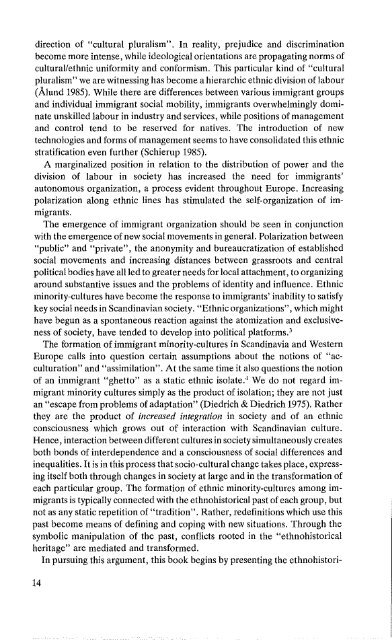Will they still be dancing? (1982)
Etnographic study of Romanians from East Serbia in Sweden in 1980s
Etnographic study of Romanians from East Serbia in Sweden in 1980s
Create successful ePaper yourself
Turn your PDF publications into a flip-book with our unique Google optimized e-Paper software.
direction of "cultural pluralism". In reality, prejudice and discrimination<br />
<strong>be</strong>come more intense, while ideological orientations are propagating norms of<br />
cultural/ethnic uniformity and conformism. This particular kind of "cultural<br />
pluralism" we are witnessing has <strong>be</strong>come a hierarchic ethnic division of labour<br />
(Alund 1985). While there are differences <strong>be</strong>tween various immigrant groups<br />
and individual immigrant social mobility, immigrants overwhelmingly dominate<br />
unskilled labour in industry and services, while positions of management<br />
and control tend to <strong>be</strong> reserved for natives. The introduction of new<br />
technologies and forms of management seems to have consolidated this ethnic<br />
stratification even further (Schierup 1985).<br />
A marginalized position in relation to the distribution of power and the<br />
division of labour in society has increased the need for immigrants'<br />
autonomous organization, a process evident throughout Europe. Increasing<br />
polarization along ethnic lines has stimulated the self-organization of immigrants.<br />
The emergence of immigrant organization should <strong>be</strong> seen in conjunction<br />
with the emergence of new social movements in general. Polarization <strong>be</strong>tween<br />
"public" and "private", the anonymity and bureaucratization of established<br />
social movements and increasing distances <strong>be</strong>tween grassroots and central<br />
political bodies have allied to greater needs for local attachment, to organizing<br />
around substantive issues and the problems of identity and influence. Ethnic<br />
minority-cultures have <strong>be</strong>come the response to immigrants' inability to satisfy<br />
key social needs in Scandinavian society. "Ethnic organizations", which might<br />
have <strong>be</strong>gun as a spontaneous reaction against the atomization and exclusiveness<br />
of society, have tended to develop into political platforms.'<br />
The formation of immigrant minority-cultures in Scandinavia and Western<br />
Europe calls into question certain assumptions about the notions of "acculturation"<br />
and "assimilation". At the same time it also questions the notion<br />
of an immigrant "ghetto" as a static ethnic isolate.' We do not regard immigrant<br />
minority cultures simply as the product of isolation; <strong>they</strong> are not just<br />
an "escape from problems of adaptation" (Diedrich & Diedrich 1975). Rather<br />
<strong>they</strong> are the product of increased integration in society and of an ethnic<br />
consciousness which grows out of interaction with Scandinavian culture.<br />
Hence, interaction <strong>be</strong>tween different cultures in society simultaneously creates<br />
both bonds of interdependence and a consciousness of social differences and<br />
inequalities. It is in this process that socio-cultural change takes place, expressing<br />
itself both through changes in society at large and in the transformation of<br />
each particular group. The formation of ethnic minority-cultures among immigrants<br />
is typically connected with the ethnohistorical past of each group, but<br />
not as any static repetition of "tradition". Rather, redefinitions which use this<br />
past <strong>be</strong>come means of defining and coping with new situations. Through the<br />
symbolic manipulation of the past, conflicts rooted in the "ethnohistorical<br />
heritage" are mediated and transformed.<br />
In pursuing this argument, this book <strong>be</strong>gins by presenting the ethnohistori-<br />
14
















